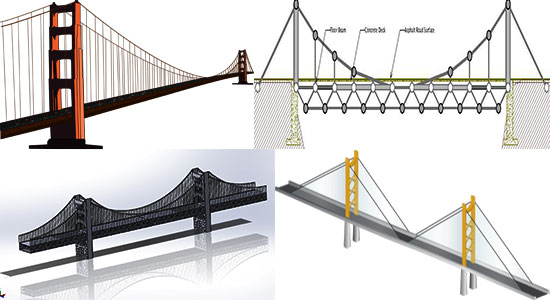This construction article focuses on uses and types of bridges.
How bridges balance forces
Things are moved through forces, but they also retain them stagnant. A bridge remains stand steels as all the forces operating on it are correctly in balance. In a nutshell, bridge designers can be described as force balancers.
Things are moved through forces, but they also retain them stagnant. A bridge remains stand steels as all the forces operating on it are correctly in balance. In a nutshell, bridge designers can be described as force balancers.
A bridge extents over a river, valley, sea, or road. There is no direct support under the enormous deck (the primary horizontal platform) of a bridge. If the bridge is lengthier, it becomes heavy and bears lots of weight. So, the chance for collapsing is increased. Bridges can sometime collapse, but most sustain securely for a prolonged period as it cautiously balance two primary types of forces known as compression (a pushing or compressing force, operating internal) and tension (a pulling or stretching force, operating external), by dispersing the load toward abutments (the supports at each side) and piers (one or more supports in the middle). There exist different types of bridges, substantially all of them function by balancing compressive forces in some areas with tensile forces somewhere else, so there does not exist universal force to induce motion and provide damage.
Carrying loads
At the time of unloading, a bridge has to provide support to its own weight (the dead load), therefore the tension and compression in its structure become really static forces (ones that don't give rise to movement) that is adjusted slightly from hour to hour or day to day. Though, by characterization bridges bear fluctuating amounts of weight (the live load) from things like railroad trains, cars, or people, which can significantly raise the ordinary tensile or compressive forces. Rail bridges, as for instance, bend and flex each time when an overweight train passes over them and then "relax" over again once the load has elapsed.
At the time of unloading, a bridge has to provide support to its own weight (the dead load), therefore the tension and compression in its structure become really static forces (ones that don't give rise to movement) that is adjusted slightly from hour to hour or day to day. Though, by characterization bridges bear fluctuating amounts of weight (the live load) from things like railroad trains, cars, or people, which can significantly raise the ordinary tensile or compressive forces. Rail bridges, as for instance, bend and flex each time when an overweight train passes over them and then "relax" over again once the load has elapsed.
To read the complete article, go through the following link.
www.explainthatstuff.com
www.explainthatstuff.com

~~~~~~~~~~~~~~~~~~~~~
Published By
Rajib Dey
www.constructioncost.co
~~~~~~~~~~~~~~~~~~~~~
No comments:
Post a Comment